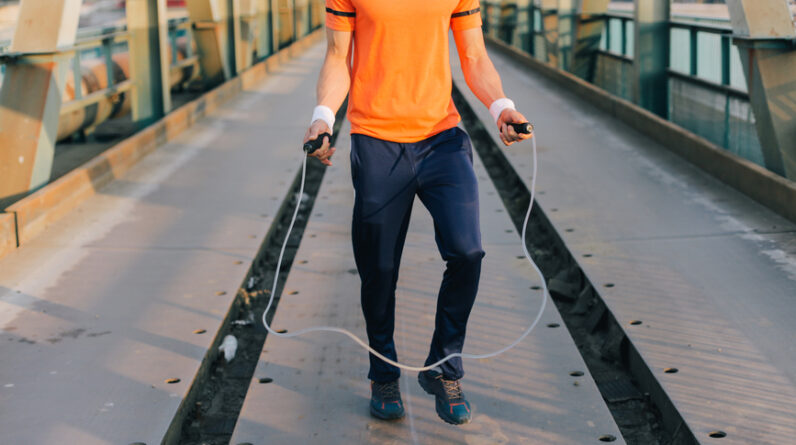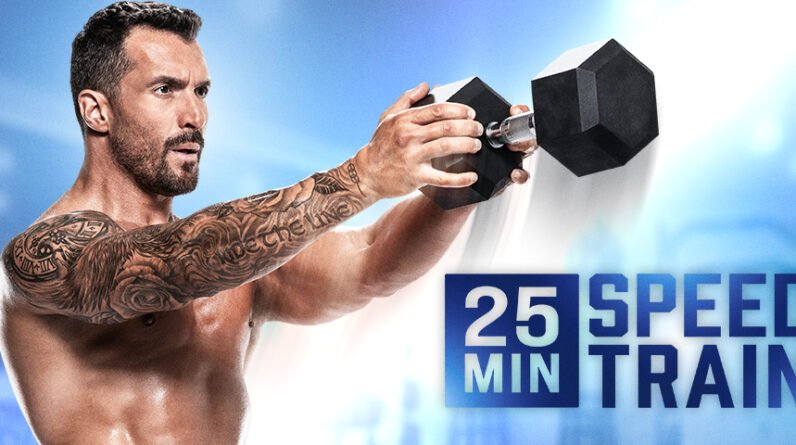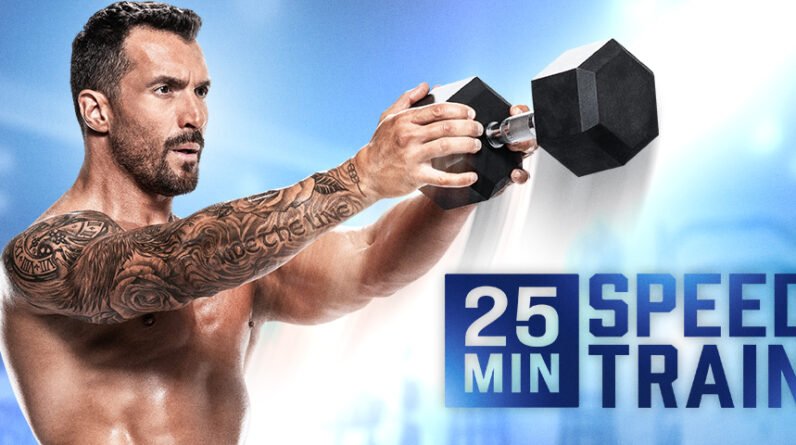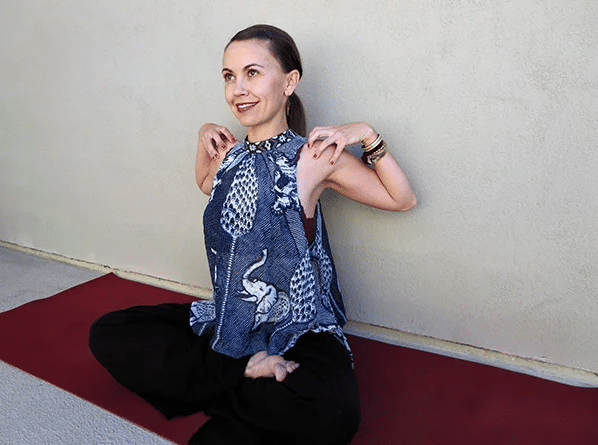
Jumping rope is a highly effective, high-intensity workout that you can do in just a matter of minutes, so it’s the perfect solution for those with a tight schedule. Jump rope benefits include protecting your heart, keeping you fit and healthy in general, and even bringing out that childlike spirit as a form of play, too.
Remember when you’d jump rope as a kid for fun? Well, now jump rope benefits extend beyond leisure and play, and they actually can lead to improvements in health and fitness, as a form of training.
“Jumping rope is a very simple and effective workout for anyone looking to improve cardiovascular health. And the beauty of jumping rope is that you don’t need a lot of time, equipment or space—you only need about 10-15 minutes, a jump rope and around 5ft x 5ft space, that’s it,” says John Shackleton, MS, CSCS, and Villanova men’s basketball head performance coach.
Experts In This Article
- John Shackleton, MS, CSCS, professional trainer and performance coach for the Villanova University men’s basketball program
As you age, you must be vigilant about activity level and prioritize regular workouts to promote cardiovascular health and lower risk of disease, and when done correctly, jumping rope definitely qualifies as a workout—one that’ll make you sweat fast and be challenging, too. Just look at the benefits of jump rope vs running: They’re surprisingly similar.
Stash a jump rope in your work bag and take it on the go or keep one at your office for easy daily workouts during your lunch hour or when you’re working late hours and need a little energy boost and pick-me-up to make it through. Plus, it’s jump rope benefits your wallet too, as it’s an affordable piece of equipment to use at home and keep in a home gym, too.
How To Jump Rope With the Proper Form
Form is everything, since if you’re not holding the jump rope correctly and keeping the right rhythm with those jumps and footwork, you won’t be able to reap those awesome jump rope benefits or get an effective workout.
Shackleton suggests using this form with jump rope workouts:
- Start by holding the rope at both ends with the middle of the rope directly behind your heels. Then stand with your feet shoulder width apart, standing up straight and with a firm grip on the handles.
- In one motion, pull the rope over the back of your head so that the middle of the rope lands right in front of, or before reaching, your front feet.
- Then jump straight up over the rope and pull the rope behind your back and over your head, once again.
You should repeat this motion, jumping straight up into the air, each time the rope lands in front of your feet. “At this point, it is key to keep your arms locked and to simply move your wrists in a circular motion in order to move the rope up above the back of your head,” Shackleton advises.
Here’s the right way to jump rope, according to Amanda Kloots:
Jump Rope Benefits
Jumping rope is great for cardiovascular endurance and overall health, as it is a terrific form of cardio and it even allows for added resistance to make it more suitable as a strength training workout, too. Here are the top jump rope benefits that make it a killer workout you can do anywhere and anytime.
1. It Builds Endurance and Stamina
Jumping rope requires focus and endurance, where you maintain the movement, footwork and rhythm without needing a break and putting the jump rope down.
“Jumping rope activates almost every muscle in your body which helps boost your heart rate quickly, and quicker even than many other exercises, and having a boosted heart rate for extended periods of time will help your body build cardiovascular endurance,” Shackleton says.
“The best way to maximize cardio endurance training with jump rope exercises is to do long jump rope sessions around 20-30 minutes per session,” says Shackleton.
2. You Spike Your Heart Rate
“Jumping rope is a high intensity workout, which means it will help you get your heart rate up quicker than low intensity workouts,” says Ryan Daly, NASM-PES, a| Sports Performance Coach for Professional Athletes. Lower-intensity workouts might include a long-distance run where you’re maintaining a moderate pace, instead of doing sprints, for example.
“To push yourself, you can try high intensity interval training (HIIT) sessions with a jump rope,” says Daly. These types of exercises include high knees, side-to-side jumps and criss-cross jumps, which you can do in a tabata style circuit (20 seconds on, followed by 20 seconds of rest, for a total of eight rounds per tabata set).
You can also maximize jump rope benefits by using the jump rope along with other bodyweight HIIT exercises for a HIIT circuit that gets your heart rate high. For instance, you could do squat jumps, mountain climbers, push-ups or tuck jumps, in between those jump rope sets.
3. It Strengthens and Builds Muscles When Weighted
While jump rope benefits are most commonly associated with cardio, jumping rope can also target muscles to provide strength, increase in mass and more definition and tone.
To be fair, the best way to build strength is by doing weight-bearing exercise, which you should implement into your fitness routine to complement cardio work, such as jump rope circuits that are HIIT focus and leave you dripping in sweat. “Jumping rope can also be used for toning muscles but is not necessarily the best exercise for muscle building, as there isn’t a lot of muscular strain taking place in a traditional jump rope session,” says Shackleton.
“However, jumping rope can certainly help maintain and tone muscles as almost all of your muscles are being activated when jumping rope, and if your goal is maintaining and building muscle try using a weighted jump rope, since adding weight increases tension needed to control the rope and adds more strain to your muscles to help you build strength,” Shackleton says.
4. It Requires Little Time but With Maximum Effort
Jump rope benefits are easy to achieve with a HIIT training workout that’s short and sweet, for when you’re pressed for time and need maximum intensity to make the most of your workout.
“If time is limited a jump rope HIIT session could be perfect,” says Daly. “In just 15 minutes you can get your heart rate working during active times within a 70 to 90 percent max heart rate and during rest periods within a 60 to 65 percent range,” says Daly. And when your heart rate is up, you’re bound to increase fitness gains and perform better, no matter how long you’re working out, as a whole.
5. It Protects Your Heart Health
When your heart is pumping within the estimated percentages Daly had provided above, oxygen and blood travel more efficiently and faster to reach the muscles. “This process can also lower cholesterol and benefit your cardiovascular health,” says Daly.
Increased, healthy blood flow is good for your heart health, cholesterol and blood pressure. When there’s oxygenated blood circulating throughout your body where it’s able to reach your muscles, especially when you’re exercising too, you’ll likely have lower blood pressure and reduced cholesterol levels.
“High blood pressure and high cholesterol are both leading causes of heart attack,” says Daly, so a quick 10-minute jump rope workout a day could provide real longevity benefits, which add up.
6. It Holds You Accountable
Jumping rope is convenient and portable, since you can carry the jump rope with you and keep it in your bag. It’s light enough, unless weighted, so it won’t cause strain on your back or shoulders or slow you down.
Plus, you can travel with jump rope, too. “If you’re in a hotel room you can simply grab the rope and jump for 10 minutes before hopping in the shower and getting on with your day,” says Daly.
Jumping rope requires minimal time, where 10-15 minutes is sufficient and effective, according to both Shackleton and Daly, and no other equipment. “It’s also more fun, so it might be easier to get motivated, than perhaps with a 30-minute workout on a cardio machine or a run,” says Daly.
7. It Improves Speed and Agility Training
“Jumping rope activates your fast twitch muscles, which is what allows you to explode quicker, and speed and agility all stem from your fast twitch muscles,” says Daly. Jump rope benefits your fast-twitch muscles and helps train them to be more agile and coordinated, with some fancy footwork and speed.
“You can also improve your balance and coordination by doing one-footed jump sessions,” suggests Daly. One-footed exercises are also challenging and yield great results.
Jump Rope Exercises To Maximize Benefits
1. Weighted Jump Rope Session (25 minutes)
“Adding a weighted jump rope is a great way to build upper body strength and reap greater jump rope benefits during a training session,” says Shackleton. “This weighted jump rope session will add muscle strain to your forearms, wrist, abs, shoulders, and your back muscles as the workout intensifies with the added resistance,” Shackleton says.
Shackleton recommends using a weighted jump rope with a 0.8lb to 1 lb range if you’re a woman and with a 1.5 to 2 lb range if you’re a man. However, you should use any weight you’re comfortable with but also feel challenged by enough—don’t limit yourself if you’re capable of surpassing this range, but make sure to ease into training with a weighted jump rope to avoid getting injured or increasing your load too quickly.
An example:
- 60 seconds of weighted jumps
- 30 seconds of rest
- Repeat 10 times
- Rest for 2-3 minutes
- 30 seconds of weighted jumps
- 15 seconds of rest
- Repeat 10 times
2. One-Legged Jump Sessions (20-30 minutes)
One-legged jump sessions work balance and coordination and prevent you from compensating with the other leg, so there’s more single-focused work and greater tension on the muscles.
“This helps to eliminate muscular imbalances and enhances your overall balance, and you also get strength improvements, as there is much more weight applied to each individual leg, as a one-legged exercise and circuit, with more tension on the calves and ankle muscles,” says Daly.
A tip? Give the rope a little swing when doing one-legged jump circuits. “When performing the one-legged jumps you are going to want to swing the rope a little bit faster, as you won’t be able to jump as high on one foot as you would on two,” says Daly.
An example:
- 60 seconds of standard jumps
- 30 seconds of rest
- 60 seconds of right leg jumps
- 30 seconds of rest
- 60 seconds of left leg jumps
- 30 seconds of rest
- Repeat 5 times
3. Double Jump HIIT Session (12 minutes)
“The double jump HIIT session is perfect for those who are trying to get their heart rate up in a short period of time, but to perform it, you must be able to do a double jump,” says Daly. A double jump is when you swing the rope over your head and under your feet twice, together as just one jump. You’ll need to jump higher and spin the rope faster than you normally would when doing a traditional jump.
“Because you are jumping higher and spinning the rope faster, this exercise is very high intensity and will get your heart rate up very quickly, which is why it is great for building cardiovascular endurance and requires the least amount of time,” says Daly.
Make sure the rope is long enough, so it offers 6 to 10 inches of room above your head for when it’s in the air. That way you can do those high jumps without restraint and the risk of getting whacked in the head.
An example:
- 45 seconds of double jumps
- 15 seconds of rest
- 45 seconds of double jumps
- 15 seconds of rest
- 45 seconds of double jumps
- 15 seconds of rest
- 1 minute of rest
- Repeat 3 times
Watch this video for another jump rope workout with all the benefits:







